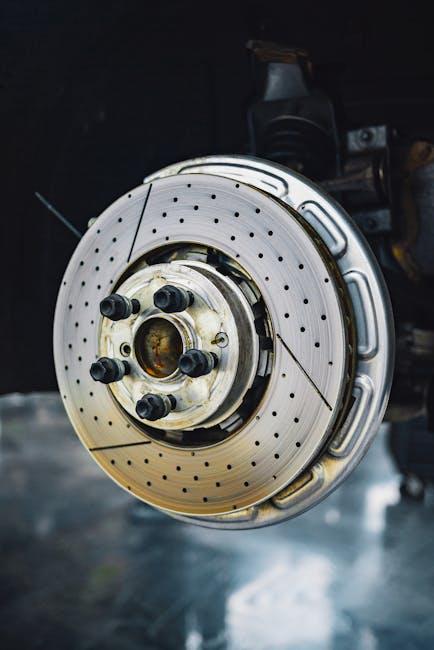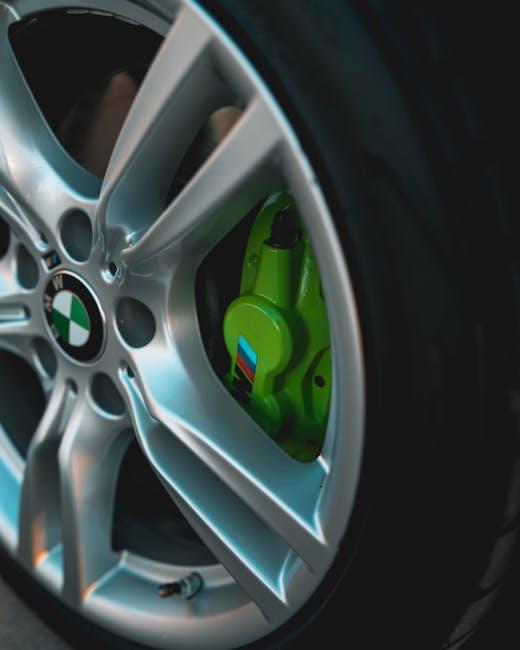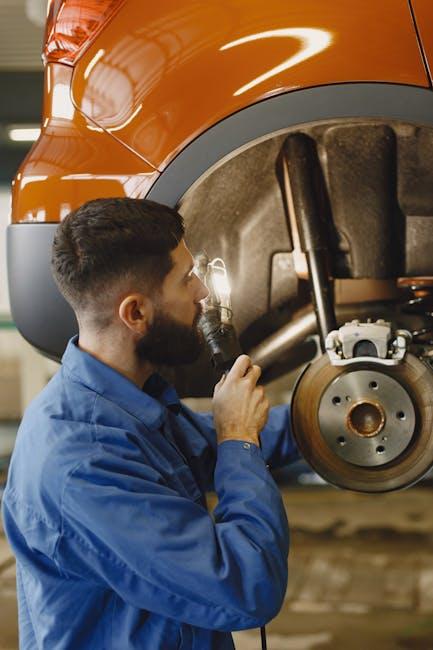There’s a certain trust we place in our car every time we press the brake pedal—a silent pact that it will respond swiftly, firmly, and reliably. But what happens when that pedal feels unexpectedly soft or spongy beneath your foot? It’s a subtle sensation, almost like pressing down on a pillow instead of the solid resistance you’re used to. This often-overlooked feeling can be more than just an odd quirk; it could be a critical warning sign from your vehicle. In this article, we’ll explore what causes that soft brake sensation, why it matters, and what steps you should take to ensure your safety on the road.
Table of Contents
- Understanding the Causes of Soft or Spongy Brakes
- How Brake Fluid Affects Pedal Feel and Performance
- Identifying Common Brake System Leaks and Their Impact
- The Role of Brake Pads and Rotors in Brake Responsiveness
- Step-by-Step Guide to Bleeding Your Brakes Safely
- When to Seek Professional Brake Inspection and Repair
- Q&A
- The Way Forward

Understanding the Causes of Soft or Spongy Brakes
When your brake pedal feels soft or spongy, it often signals an underlying issue in your vehicle’s braking system. One common cause is air trapped within the brake lines. Air compresses under pressure, unlike brake fluid, which means the pedal won’t feel firm when pressed. Another frequent culprit is brake fluid leakage, which reduces hydraulic pressure and can jeopardize your vehicle’s stopping power. Worn brake components such as pads, rotors, or calipers can also contribute to the sensation by preventing the brakes from engaging properly.
To better understand potential causes, consider this quick overview:
| Cause | Effect on Brakes | Signs to Watch For |
|---|---|---|
| Air in Brake Lines | Soft pedal, reduced braking power | Brake pedal sinks to the floor |
| Brake Fluid Leak | Warning lights, low fluid level | Fluid puddles under car |
| Worn Brake Pads | Longer stopping distances | Squealing noises, vibration |
- Contaminated brake fluid reducing efficiency
- Damaged master cylinder impairing pressure creation
- Collapsed brake hoses restricting fluid flow

How Brake Fluid Affects Pedal Feel and Performance
When your brake pedal feels soft or spongy, the culprit often lies in the quality and condition of the brake fluid. This vital fluid transmits the force from your foot on the pedal directly to the brake calipers, creating the stopping power essential for safe driving. Over time, brake fluid can absorb moisture from the air, which lowers its boiling point and leads to decreased hydraulic efficiency. This moisture intrusion not only diminishes pedal firmness but can also cause corrosion within brake components, further degrading performance. Maintaining fresh, high-quality brake fluid ensures consistent pressure transfer and a crisp, confident pedal feel.
Signs that brake fluid is affecting your pedal include:
- Longer pedal travel: You may have to press the pedal further than usual before brakes engage.
- Soft resistance: The pedal may feel mushy or less responsive underfoot.
- Uneven braking: Inconsistent pressure can cause the car to pull to one side when stopping.
| Brake Fluid Condition | Effect on Pedal Feel | Recommended Action |
|---|---|---|
| Fresh & Dry | Firm and Responsive | Maintain Regular Change |
| Moisture Contaminated | Spongy & Soft | Flush and Replace Fluid |
| Old & Darkened | Reduced Stopping Power | Immediate Fluid Replacement |

Identifying Common Brake System Leaks and Their Impact
Leaks in your brake system often start subtly, yet their consequences can escalate quickly if unnoticed. The most frequent culprits include:
- Master Cylinder Seals: These seals can deteriorate, allowing brake fluid to escape and air to enter the system.
- Brake Line Fittings: Corrosion or physical damage can create tiny cracks or gaps, leading to fluid seepage.
- Caliper Pistons: Worn or damaged piston seals often cause localized leaks near the wheels.
- Brake Hoses: Flexible hoses are prone to aging, cracking, and weakening, making them prime spots for leaks.
Such leaks reduce hydraulic pressure, causing the brake pedal to feel soft or spongy, which compromises your ability to stop effectively.
Understanding the implications of these leaks is crucial for maintaining both safety and vehicle performance. Below is a brief overview of how different leaks impact your brake system:
| Leak Location | Impact on Brake Performance |
|---|---|
| Master Cylinder | Reduced pressure, pedal sinks to the floor |
| Brake Lines | Loss of fluid, uneven braking response |
| Calipers | Dragging brakes, fluid pooling near wheel |
| Brake Hoses | Intermittent pressure, pedal pulsations |
Failing to address these leaks not only affects how your brakes feel underfoot but may also lead to dangerous brake failure. Regularly inspect your brake components and top off or replace fluid as needed to keep your stopping power sharp and reliable.

The Role of Brake Pads and Rotors in Brake Responsiveness
When you press the brake pedal and notice a soft or spongy sensation, it often points to the critical interplay between brake pads and rotors. Brake pads are the friction material that presses against the rotors to slow down your vehicle. Over time, worn-out or glazed pads can reduce their effectiveness, leading to decreased responsiveness and a mushy feel underfoot. Similarly, rotors that become warped or uneven due to heat and wear lose their smooth contact surface, causing vibrations and inconsistent braking pressure. Ensuring both components are in optimal condition is essential for maintaining that firm, confident pedal feel every driver relies on.
Several factors influence how these components affect your brake system performance, including:
- Material composition: Different brake pads (ceramic, semi-metallic, organic) offer varying friction and heat resistance.
- Rotor thickness and condition: Rotors must meet the minimum thickness specifications to prevent dip or pulsation.
- Installation quality: Proper alignment and bedding-in of pads and rotors enhance consistent braking response.
| Component | Common Issue | Effect on Brake Feel |
|---|---|---|
| Brake Pads | Worn or Contaminated | Reduced grip, soft pedal |
| Rotors | Warped or Too Thin | Vibration, inconsistent pressure |

Step-by-Step Guide to Bleeding Your Brakes Safely
Begin by preparing your workspace: ensure your vehicle is securely lifted and that you’re equipped with a brake fluid compatible with your system. Locate the brake bleeder valves on each wheel—typically found near the caliper or wheel cylinder. Having a clear arrangement of your tools nearby, including a wrench, a clear container with a hose to catch fluid, and fresh brake fluid, ensures a smooth process. Remember, patience is key; rushing risks introducing air bubbles back into the system.
Next, enlist a helper to gently press the brake pedal while you open the bleeder valves one at a time. Watch for air bubbles escaping through the clear hose as the fluid flows; this signals the removal of trapped air. Close the valve tightly before your assistant releases the pedal to avoid pulling air back into the system. Proceed with this for each wheel, often starting from the furthest wheel from the master cylinder and moving closer. Regularly top off the master cylinder to prevent it from running dry and compromising your bleeding efforts.

When to Seek Professional Brake Inspection and Repair
Recognizing the right moment to have your brakes checked by a professional can prevent minor issues from becoming costly repairs. If you notice unusual sensations such as hitting the pedal and feeling an unexpected softness or sponginess, it’s a clear signal your braking system requires immediate attention. Other signs include:
- Increased stopping distances
- Brake pedal sinking to the floor
- Vibration or pulsation when braking
- Unusual noises like squealing or grinding
- Warning lights on your dashboard
Delaying inspection can compromise not only your vehicle but your safety on the road. Professionals use specialized diagnostic tools to detect hidden problems such as air in the brake lines, worn-out brake pads, or fluid leaks. Here’s a quick overview of common brake issues and their symptoms that a mechanic can identify effectively:
| Issue | Symptom | Potential Cause |
|---|---|---|
| Soft Pedal | Spongy feeling when pressed | Air in brake lines, low brake fluid |
| Grinding Noise | Squealing or scraping sounds | Worn brake pads |
| Longer Stopping Distance | Brakes take longer to slow vehicle | Brake fluid contamination, worn rotors |
| Pedal Sinks | Brake pedal goes to floor | Hydraulic system leak |
Q&A
Q: What does it mean if my brakes feel soft or spongy?
A: A soft or spongy brake pedal usually indicates that there is air trapped in the brake lines or a problem with the brake fluid. Instead of firm resistance, the pedal feels squishy when you press it, which can compromise your braking performance.
Q: Why do brakes start to feel spongy over time?
A: Over time, moisture can enter the brake fluid, reducing its effectiveness. Additionally, microscopic air bubbles or leaks in the brake system can cause the pedal to lose its firmness, leading to that unsettling soft sensation.
Q: Is it dangerous to drive with soft or spongy brakes?
A: Yes. Soft or spongy brakes reduce your vehicle’s stopping power and increase your stopping distance. This can be a serious safety hazard, so it’s important to address the issue promptly.
Q: Can I fix soft or spongy brakes myself?
A: If you are mechanically skilled, you might attempt to bleed the brakes to remove air bubbles from the lines. However, brake systems are critical for safety, so many experts recommend having a professional inspect and repair your brakes.
Q: What are some common causes of spongy brakes besides air in the brake lines?
A: Other causes can include worn brake pads, damaged brake hoses, leaking brake fluid, or a failing master cylinder. Each of these issues affects pedal feel and overall braking efficiency.
Q: How can I prevent my brakes from feeling soft or spongy?
A: Regular brake maintenance is key. This includes checking and replacing brake fluid as recommended, inspecting brake lines and components, and addressing any leaks or wear promptly.
Q: What should I do if my brakes suddenly feel soft or spongy while driving?
A: If you notice a sudden change in brake pedal feel, safely pull over and avoid driving if possible. Call for roadside assistance or have the vehicle towed to a mechanic to prevent any accidents.
Q: Does temperature or weather affect brake pedal feel?
A: Extreme temperatures or humidity can affect brake fluid moisture content, sometimes leading to pedal softness. Cold weather can also cause brake components to contract slightly, impacting feel temporarily.
Q: Are there any warning signs besides a soft pedal that suggest brake problems?
A: Yes. Warning signs include unusual noises when braking, brake warning lights on your dashboard, vibrations, or longer stopping distances. These symptoms should be checked alongside pedal feel.
Q: How often should I have my braking system inspected?
A: Generally, having your brakes inspected at least once a year or as recommended in your vehicle’s owner manual helps keep the system in safe working order and prevents issues like a spongy pedal.
The Way Forward
In the end, soft or spongy brakes are more than just a fleeting nuisance—they are your vehicle’s way of signaling that something’s amiss. Whether it’s air in the brake lines, worn components, or fluid issues, addressing these symptoms early can mean the difference between a smooth stop and a risky slide. So next time you press the pedal and feel that unexpected give, listen closely. Your brakes might be whispering a warning, urging you to take action before it’s too late. Stay alert, stay safe, and let your brakes speak clearly again.
